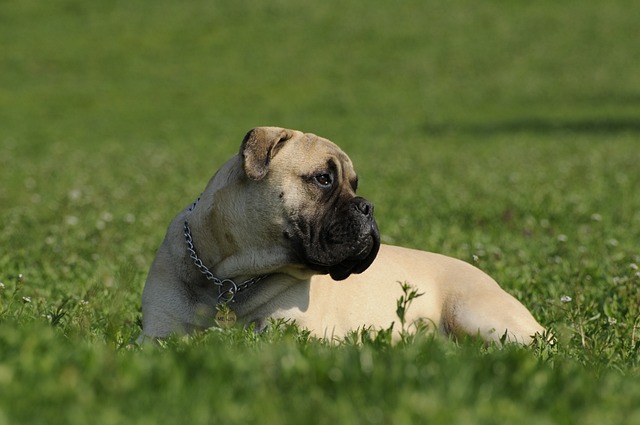


The Bullmastiff is a large, powerful, and protective breed originally bred to guard estates and property. Known for their calm and gentle nature, Bullmastiffs are loyal companions who are particularly devoted to their families. They are highly alert and make excellent guard dogs, yet they are also affectionate and good with children when properly socialized. Despite their imposing size and strength, Bullmastiffs are often described as gentle giants, making them well-suited for families that are prepared to provide them with consistent training and care.
The Bullmastiff was originally developed in the 19th century in England as a guard dog for gamekeepers, who needed a dog that could protect large estates and prevent poaching. The breed is a cross between the English Mastiff and the Bulldog, resulting in a dog that is strong, courageous, and capable of deterring intruders. The Bullmastiff's role was to track down and subdue poachers without causing serious harm, which required a combination of physical strength and restraint. The breed quickly gained popularity for its guarding abilities, and by the late 1800s, the Bullmastiff was recognized as a distinct breed. Today, they continue to serve as guard dogs, but they are also beloved family pets.
The Bullmastiff is a large and muscular dog, with a well-proportioned, sturdy body. Males typically stand between 25 to 27 inches tall at the shoulder and weigh between 110 to 130 pounds, while females are slightly smaller. They have a broad, square-shaped head with a short, wide muzzle and a distinctive black mask around their eyes and nose. Their coat is short and dense, coming in shades of fawn, brindle, or red. Bullmastiffs have deep-set, dark eyes that give them an alert and watchful expression. Their ears are medium-sized and triangular, and their tail is thick, tapering, and carried low. Despite their imposing size, Bullmastiffs move with surprising agility and grace.
The Bullmastiff is known for being calm, confident, and protective. While they can be aloof with strangers, they are incredibly devoted to their family members and are known for their loyalty and affection. These dogs are often described as gentle giants due to their loving nature, especially with children. They are patient and tolerant, making them great family pets, though early socialization is important to ensure they are well-mannered around other pets and strangers. Bullmastiffs are naturally protective and alert, making them excellent watchdogs. However, they are not typically aggressive and are more likely to be reserved or defensive when confronted with a threat. Their independent streak means that they may not always follow commands immediately, so they require consistent training and leadership.
Despite their large size, Bullmastiffs do not require an excessive amount of exercise. They are relatively low-energy dogs, and while they enjoy daily walks, they are not as active as some other breeds. Short, regular walks and some time in a securely fenced yard are usually sufficient for most Bullmastiffs. Because they are prone to joint issues like hip dysplasia, it is important not to over-exercise them, especially when they are young. Bullmastiffs enjoy spending time with their families and may participate in activities like obedience training, gentle play, or short hikes. Mental stimulation is just as important as physical exercise, and Bullmastiffs will appreciate interactive toys or tasks that challenge their intelligence.
Training the Bullmastiff requires patience, consistency, and firm leadership. While they are intelligent and eager to please, their independent nature can make training a challenge for first-time dog owners. Positive reinforcement methods, such as treats and praise, work well with this breed, but it is important to establish clear boundaries early on. Bullmastiffs respond best to calm, confident handlers who can provide consistent direction. Early socialization is crucial to ensure that they grow up to be well-behaved and confident dogs. Introducing them to various people, animals, and environments will help them develop into balanced adults. It is also important to start obedience training early, as Bullmastiffs can be strong-willed and may attempt to take charge if they are not taught to respect their owners.
Overall, the Bullmastiff is a relatively healthy breed, but they are prone to certain health issues due to their size. Some of the most common conditions in Bullmastiffs include hip dysplasia, elbow dysplasia, bloat (gastric torsion), and heart problems. Regular veterinary check-ups are essential for maintaining their health and addressing any potential concerns early. Because of their short coat, Bullmastiffs do not require extensive grooming, but they do shed moderately, so regular brushing will help keep their coat healthy and remove loose hair. Cleaning their ears and trimming their nails regularly is also important. Due to their large size, it is important to monitor their weight to avoid obesity, which can exacerbate joint problems and other health issues.
The Bullmastiff has a lifespan of approximately 8 to 10 years, which is typical for large breeds. To help ensure a long and healthy life, it is important to provide them with proper care, including regular exercise, a balanced diet, and routine veterinary visits. Maintaining a healthy weight and preventing joint problems can also contribute to their overall well-being. While their lifespan may be shorter than smaller breeds, with the right care, Bullmastiffs can enjoy many years as loyal and loving companions.
© copyright Dog Compendium 2024 - 2025